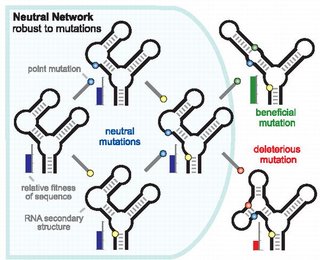Wednesday, December 13, 2006
Balancing Robustness and Evolvability
From PloS Biology:
Balancing Robustness and Evolvability
Richard E. Lenski et al.
One of the most important features of biology is the ability of organisms to persist in the face of changing conditions. Consider the remarkable fact that every organism alive today is the product of billions of generations in which its progenitors, without fail, managed to produce progeny that survived to reproduce. To achieve this consistency, organisms must have a balance between robustness and evolvability, that is, between resisting and allowing change in their own internal states [1 - 3]. Moreover, they must achieve this balance on multiple time scales, including physiological responses to changes over an individual life and evolutionary responses, in which a population of genomes continually updates its encoded information about past environments and how future generations should respond given that record.
Examples of robust biological systems are found at many scales, from biochemical to ecological. At each scale, robustness may reflect the properties of individual elements or, alternatively, the dynamic feedbacks between interacting elements. The expression of some metabolic function, for example, may be robust in the face of temperature change, because an enzyme maintains its shape and specificity across a range of temperatures or because an interconnected network of reactions sustains the supply of product, even when some enzyme fails. A genome may be robust because it encodes proofreading and repair systems that reduce replication errors or because it is organized such that many mutations have little effect on its phenotype. An ecosystem might be robust if it resists the extinction of some keystone species or, if extinction does occur, because surviving species can compensate over physiological, demographic, or evolutionary time scales.
One important question is whether there exists a single unifying mathematical framework that can encompass such diverse examples of biological robustness. Might new insights come from such a conceptual unification, or will future understanding require detailed analyses of specific cases? Across the different scales, recurring mechanisms for achieving robustness - including redundancy of component parts and negative feedbacks - might serve as organizing principles. Yet, similarities in mechanism could mask important differences in the evolutionary origins of those mechanisms. At the level of genes in genomes or of cells in multicellular organisms, it is reasonable to suggest that redundancy evolved by natural selection to maintain some functional capacity in the face of perturbation [4]. But whereas species redundancy could also be critical for robustness of ecosystem functions, differences in redundancy might be an emergent property rather than an ecosystem-level adaptation, because selection generally acts at lower levels (but see [5] for another view).
Continued at "Balancing Robustness and Evolvability" [A modified version of this post (with background info) will be posted to the "General Evolution News" category]
Technorati: balancing, robustness, evolvability, biology, organisms, conditions, generations, progeny, genome, repair, systems, framework, genes, evolutionary, origins, multicellular, demographic, physiological, ecosytem, redundancy, richard, e, lenski, adaptation, phenotype, natural selection, emergent, property, level, keystone, species, extinction
Add to: CiteUlike | Connotea | Del.icio.us | Digg | Furl | Newsvine | Reddit | Yahoo
